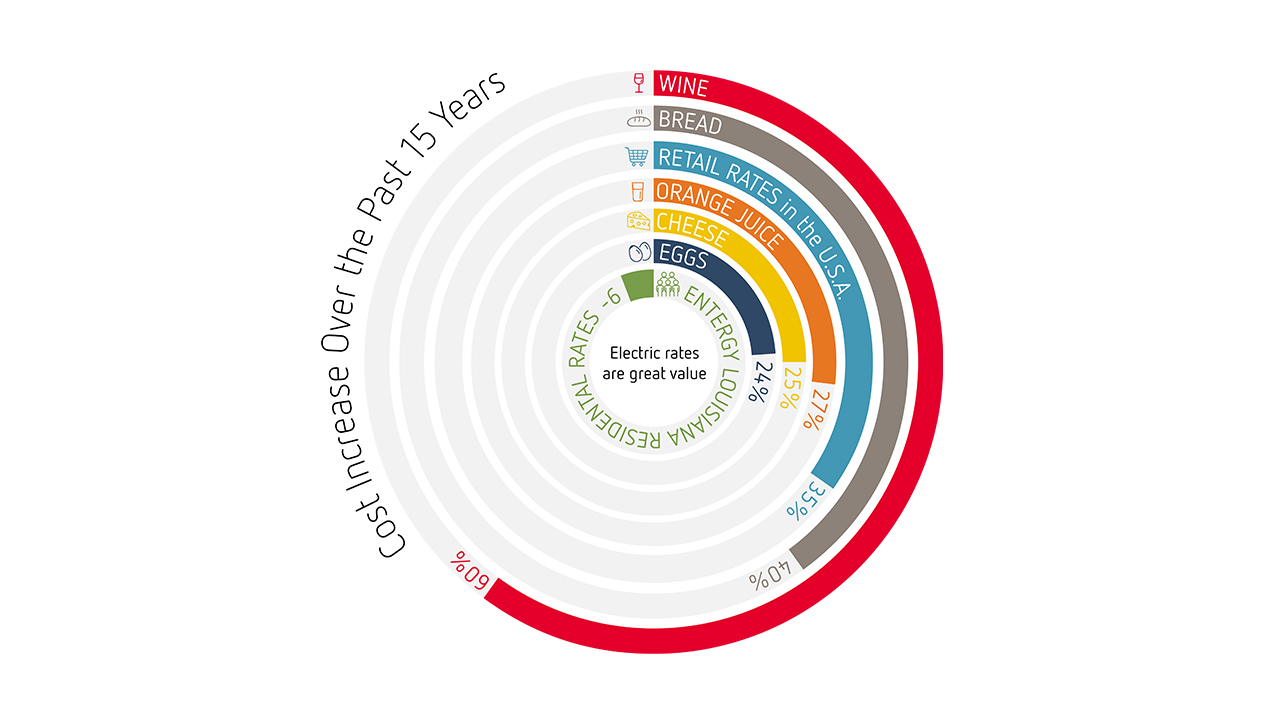Insights > A Top Priority for Us: Keeping Your Utility Bill Affordable
A Top Priority for Us: Keeping Your Utility Bill Affordable
08/16/2021

Despite consistently rising prices throughout the marketplace, Entergy Louisiana residential rates have declined by 6% over the last 15 years.
That’s right, our residential rates have gone down while staples in the grocery store like bread, cheese and orange juice cost more these days. Other basic goods and services like gasoline and cell phones have also increased in price faster than the rate of inflation.
Something to Consider: Extreme Weather Can Drive Up Usage
What drives the size of your utility bill is largely the amount of power used each month. Naturally, Louisiana residents tend to use more power than in many other areas of the country in order to cool their homes, especially in the heat of the summer. This is why you may notice increases to your electricity bill as the temperature outside rises.
While the average Louisiana residential customers’ use ranks among the highest in the nation, the typical Louisiana household bill falls near the middle of the pack compared to other states. This is due to Entergy Louisiana’s low rates offsetting some of the additional expected costs of being in an area that requires high levels of energy consumption.
What Do These Bill Line Items Mean?
The company continues to make smart and disciplined investments to maintain affordable rates. No matter the price of your power bill, to better manage your bill and save even more money, it helps to understand some of the charges that appear on your bill and why. Some important items include:
- The energy charge line item, set by the Louisiana Public Service Commission (“LPSC”), covers the general cost of providing electric service. For example, the energy charge covers the cost of wires, poles, power plants, and other customer service-related costs, such as service trucks and customer contact centers. The amount of the charge will vary from month to month based on a customer’s usage.
- The fuel adjustment charge will change on your bill from month to month and is the most dynamic item. The charge reflects the actual cost of generation fuel and purchased energy for that billing period. Entergy makes no profit on this, and the charge is passed through to customers as directed by the LPSC.
- The storm restoration charge on your bill represents the monies collected to repay the financing of the storm restoration costs and storm reserves. Working with the LPSC, we used special bond financing options that are spread over a number of years to save customers millions of dollars. The bonds used to finance hurricanes Katrina and Rita costs have been repaid and are no longer included in the storm restoration line item. Gustav and Ike bond repayments started in 2010 and will expire in 2022. Isaac started in 2014 and will expire in 2026. The amount of this charge will vary from month to month based on a customer’s usage.
- The storm restoration offset line item on your bill represents customer savings in the form of benefits realized because of the special financing approved by the LPSC. Both the storm restoration charge and the storm restoration offset line item are subject to adjustments during the year. This, too, may vary from month to month based on a customer’s usage. You can find more information on storm-related charges here.
- The Municipal Franchise fee is the surcharge your local government collects from Entergy to serve electricity in your area.
To learn more about the line items that appear on your bill, click here.
How You Can Save Money on Your Utility Bill
There are everyday things you do at home that impact your electric bill as well, such as charge cell phones, cool or heat your home, wash laundry and take a hot shower. Customers can lower monthly electric bills even more by taking steps to reduce energy usage or taking advantage of energy efficiency ideas and products at the Entergy Solutions Marketplace.
To find all types of statistics on electric power, consumption, prices, sales and customers, visit U.S. Energy Information Administration website.

